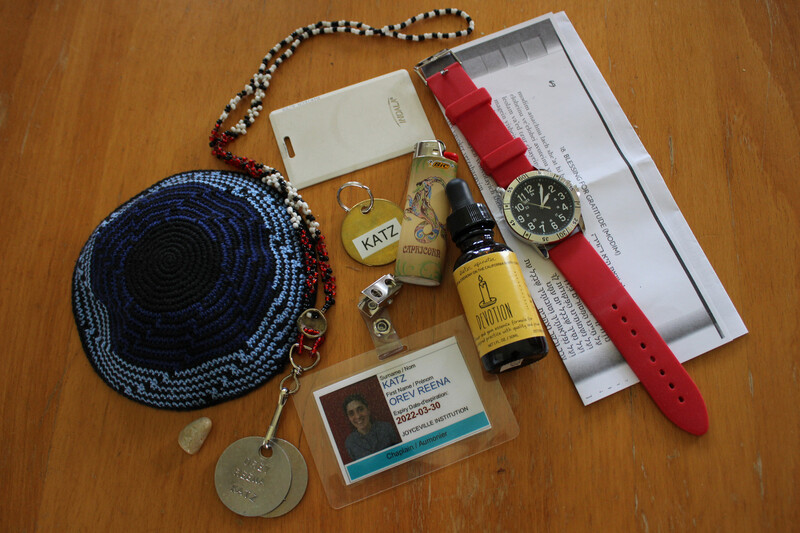- 00.0Cover & EditorialAnchi Lin, Letters & Handshakes
- 00.1Care and Dying: Albert Banerjee in Conversation with Steven EastwoodAlbert Banerjee, Steven Eastwood
- 00.2Care as InfrastructureAi-jen Poo, Letters & Handshakes
- 00.3covering, distribution, cleaning my instrumentRadiodress
- 00.4Dilemmas of CareEmma Dowling
- 00.5CareForceMarisa Morán Jahn
- 00.6Antinomies of Self-CareLauren Fournier, Lynx Sainte-Marie, Sarah Sharma
- 00.7Other forms of convivialityPark McArthur, Constantina Zavitsanos
- 00.8It Takes Work to Get the Natural LookChloé Roubert, Gemma Savio
- 00.9Water is LifeOnaman Collective
- 00.10Seniors' Advocacy in OntarioCare Watch, Kassandra Hangdaan
- 00.11In Sickness and StudyCarolyn Lazard
- 00.12Shut. Muskrat. DownLabrador Land Protectors
covering, distribution, cleaning my instrument
- Radiodress

Toolkit contents: personal ID cards and tags used for entrance to federal prisons and their Chapels; crocheted labyrinth kippa; watch; capricorn lighter; Sister Spinster “Devotion” tincture; beaded lanyard from the Lake Sebu School (gifted by Jo Simalaya); photocopied blessing of gratitude in Hebrew/English, using the name of the Feminine Divine, Shekhinah.
Providing spiritual care to incarcerated people is a tangle of contradictions. I dance between private sanctuaries, individual positions, and public weakness. All over Turtle Island, the physical space of prisons, as well as their internal rosters of “education,” “work,” and “programming,” reveal state-sanctioned violence, control, and revenge. Yet there are leaks, cracks, and fissures where resistance and solidarity emerge. We are the witches, the bitches, the resistors in recovery—the wounded ones who know ourselves, too, to be criminal.
On my laminated Federal Corrections Staff ID card, I am smiling in a denim shirt against a red background. “Chaplain/Aumonier,” states my title. In training, we were called Spiritual Care Providers. This attempt at a more inclusive term was developed in the 1920s by Anton T. Boisen, an American consumer/survivor and Presbyterian minister. After a psychotic episode and hospitalization, Boisen recognized that most faiths have few tools with which to encounter the multiplicity, dis/embodiment, and neurodiversity in the people living, often incarcerated, in these institutions.11“Treating the Soul: A History of Spiritual Care,” Centre for Addition and Mental Health, Toronto, http://www.camh.ca/en/hospital/about_camh/newsroom/CAMH_in_the_headlines/stories/Pages/Treating-the-soul-a-history-of-spiritual-care.aspx.
The word Chaplain derives from the Latin capella, or covering. It refers to portable field tents used by Western military forces as chapels for prayer. When my name appears next to this history, I wince, and wink: a Jew, a female-bodied person, a queer, a Priestess, all of me/us squished under a Latin word for army tent. The French term Aumonier comes from a role prescribed by the Catholic Church. The Aumonier distributed alms to low-income people, including the incarcerated. The Aumonier was a kind of go-between-worlds, someone willing to get dirty in spaces deemed unreachable, impenetrable, undesirable. 22J.T.L. James, A Living Tradition: Penitentiary Chaplaincy (Ottawa: Chaplaincy Division of Correctional Service Canada, 1990).
Non-incarcerated people working in prisons have few opportunities to understand the full humanity of an incarcerated person and the wounds that led them to make the life choices they have made. The white supremacist, classist, anti-Indigenous, transphobic, misogynist, and utterly limited thinking behind the penitentiary model is embedded in our titles as paid staff in prisons. Prison Chaplains are but age-old cogs in a structure of control and compliance.
Still, I understand my work to be about witness, justice, transcendence, and empowerment. This framework disrupts a system so delicately poised around othering, mockery, simplification, and fear. I see my work as community labour. I work to build solidarity between communities of incarcerated people, the non/un-incarcerated that support them, and the greater mystery beyond. New language, which departs from the Chaplain-as-friendly-vicar and Aumonier-as-charity-distributor, might insist on mutual vulnerability, an interdependence of fracture, where human resilience and brokenness shine in.
See Connections ⤴